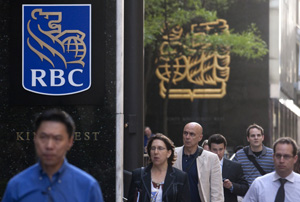
Royal Bank of Canada joined its peers this quarter in setting more money aside for potentially bad loans, but the bank is also working to position itself to capture the substantial sums of money lying in wait for when economic trends shift.
RBC chief risk officer Graeme Hepworth said the economic outlook is improving overall.
“The market continues to gain confidence that interest rates have peaked to the current cycle, and the probability of a hard landing of the economy is decreasing,” Hepworth told a conference call with investors to discuss the bank’s latest results on Wednesday.
The bank’s provisions for credit losses totalled $813 million for its first quarter, up from $532 million a year earlier, as pockets of concern rose.
Commercial real estate, especially U.S. offices, has been a big area of worry, while consumer strain in Canada has also been growing in areas like credit cards and auto loans, and in mortgages to a much lesser extent.
But the bank is operating from a cautious perspective and the provisions don’t mean it will lose money on the loans necessarily.
RBC’s forecast that a recession would hit last summer came and went, and the Canadian economy is still managing growth. Statistics Canada’s preliminary estimate put GDP growth at 1.2% annualized in the fourth quarter, with a final read set to be released Thursday.
The bank’s loan-loss provisions are also based on its expectation that unemployment will rise to 6.6% this summer, but it acknowledges that its forecasts have been challenged by the economic reality. The unemployment rate was 5.7% in January.
“Unemployment in Canada has proven to be a little bit more resilient than we had anticipated,” Hepworth said.
Unemployment and interest rates are key determining factors in how many people will default on loans. Prices, whether it’s for homes or offices, is the other main driver, Hepworth said.
With the interest rate trajectory a little more clear, employment holding up well and home prices only notching down slightly in the latest monthly report from the Canadian Real Estate Association, fears of rising mortgage defaults are easing.
Instead, with the Bank of Canada talking about when it will lower rates rather than if, there is an increasing focus on what lower rates may trigger.
RBC expects to see a big pickup in capital markets revenue when rates start to dip, that will shake off the subdued market for acquisitions and money raising.
RBC chief executive Dave McKay said the bank is already seeing activity pick up.
“We’re engaging in increased dialogue with corporate clients. Furthermore, we expect private equity activity to ramp up as sponsors sit on significant levels of uninvested client funds,” he said.
McKay did caution that there’s still uncertainty on when the flow of deals will rebuild sustainably.
In retail banking, RBC is working to position itself to capture money that is expected to come out of guaranteed investment certificates once rates move lower.
“One of the dimensions that we all struggle to predict is what’s going to happen with the $350 billion of consumer deposits that largely sit in GICs right now,” McKay said.
“Some will flow as we expect back into equities and back into investment products. Some will create stimulative demand.”
The large pool of GICs and cash set aside in Canada is different than the U.S. where the pandemic surpluses have largely been spent, he said. In Canada, the buffer is helping to soften the blow of higher interest rates, even though much of it remains unspent
The bank continues to see money come into GICs as customers added about $10 billion quarter-over-quarter, McKay said.
“So we’re watching that carefully to see how that gets deployed, but it can serve all those purposes, right, a buffer for risk, a stimulant for growth and a higher yield into investment products,” he said.
RBC is itself also sitting on lots of cash with a capital ratio of 14.9%. This is in part because it’s still waiting for its HSBC Canada deal to close, expected on March 28.
But the bank has also decided it has enough of a buffer that’s turning off its dividend reinvestment plan discount, which is used to build capital.
And even as many wait for a shift in the economy, Canada’s growing population and other factors like a strong U.S. economy are helping keep bank earnings robust.
RBC reported a first-quarter profit of $3.58 billion, up from $3.13 billion a year earlier, on revenue of $13.49 billion.
On an adjusted basis, the bank says it earned $2.85 per diluted share in its most recent quarter, down from an adjusted profit of $3.04 per diluted share in the same quarter last year.
The average analyst estimate had been for a profit of $2.80 per share, according to estimates compiled by financial markets data firm Refinitiv.
The diversified earnings of the bank more than offset pockets of worry in commercial real estate and Canadian unsecured retail portfolios, McKay said.
“I would say a very strong start to the year characterized by really good client flow across all our businesses.”